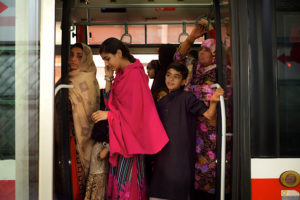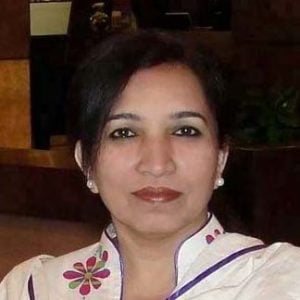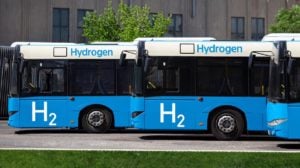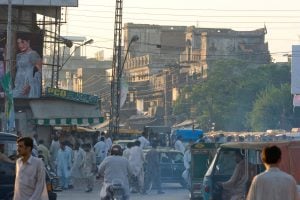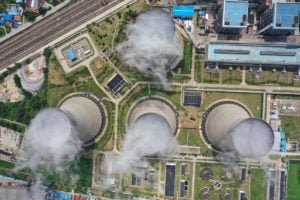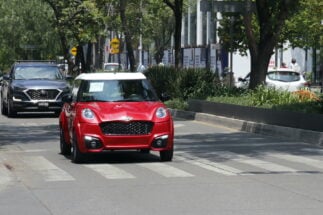Until a few months ago, Samia Gul could kick, dribble and manoeuvre a football like a star player. The 12-year-old, who hails from Pakistan’s “football district” Lyari in southern Karachi, wanted to join Pakistan’s national women’s football team.
Editor’s note
A longer version of this article was originally published by Heinrich Böll Stiftung, a German environmental foundation, and is republished here with permission.
This article cannot be republished without permission from Heinrich Böll Stiftung.
But her dream was shattered late last year when she was diagnosed with asthma. Doctors told her she had to stop intense running.
Gul is one of tens of thousands of Pakistanis who develop health conditions like asthma every year. Health experts say a key factor, especially in major cities, is ever-increasing air pollution.
Karachi, the country’s largest city and commercial capital, home to nearly 20 million people, is the fourth most polluted city in the world, according to Swiss air quality technology company IQAirPakistan. Besides Karachi, Pakistan’s second-largest city Lahore, northwestern Peshawar, Rawalpindi and textile hub Faisalabad are highly polluted.
Gul is heartbroken that the pollution in her city has taken a toll on her dream of becoming a professional footballer. “I was taking part in a routine practice match [a few months ago] when I felt difficulty breathing. I knelt to the ground in an attempt to settle down but soon realised I could not breathe properly. I fell to the ground, and was rushed to the hospital, where the doctors told me ‘a bad news’,” a visibly dejected Gul said. “It seemed as if the world was over for me when my doctor told me that I could not play football [because of asthma], at least in the near future.”
But this was not her only problem.
The lack of a proper, well-run transport system affects the majority of citizens in Pakistan’s big cities like Karachi. But it takes a particular toll on women, who face regular sexual harassment.
To travel to the football ground, Gul used public transport, which took about half an hour. In this short time she was often harassed by boys at the bus stop or on her way to the ground and back home.
It seemed as if the world was over for me when my doctor told me that I could not play football [because of asthma]Samia Gul
Gul, nonetheless, is not ready to give in. “I am taking medicine and have started jogging. The doctors and my coach are hopeful that I can regain my strength and energy gradually through medication and practice. However, it will take some time,” she said.
Talat Iqbal has a similar story. The 34-year-old resident of Korangi, a locality in eastern Karachi, said she had to leave her job due to “consistent” harassment on public transport.
Until a few months ago, she worked as a supervisor in a local garment factory. She quit after being subjected to harassment by pedestrians and passengers on the bus.
“I initially kept quiet. But when it became a routine affair, I informed my mother, who deputed my younger brother to go with me to the bus stop. However, it did not last long and one day my family ordered me to quit the job and stay home,” Iqbal said.
With her family already struggling to make ends meet, this added to her family’s economic difficulties.
Travelling on public transport is nothing short of a nightmareTalat Iqbal
The two stories show the problems faced by women in Pakistan’s cities. Increasing air pollution destroys the dreams of girls like Gul, while congested transport makes harassment frequent and easy, cutting women like Iqbal off from employment. It is a sad truth accepted and endured by most women in big cities like Karachi.
Karachi’s glorious past
Today’s smoky, noisy Karachi is a picture of glossy skyscrapers, concrete buildings and massive traffic jams. But it was very different only 50 years ago, according to older Karachiites. Aleemuddin, 70, a resident of Karachi’s densely populated Garden East neighborhood, said the city’s streets were washed daily and tall trees swayed on both sides of the roads.
Buses, trams, bicycles, rickshaws and tim-tim (horse-drawn carriages) passed through the tree-lined streets. There were few cars, no crowds, no smoke or pollution, no loud horns, and a cooling sea breeze in the evenings.
Fareed Ahmed Lucknowi, chief executive of Lucknow Transport Company, said that bicycle-drawn rickshaws probably stopped operating in the 1960s, when motorised rickshaws came onto the roads. With the introduction of the circular railway in the late 1960s, a large portion of the rapidly growing population got access to cheap transportation. But the circular railway was closed in 1999 due to lack of maintenance and funding.
Dilapidated public transport
For two years, Iqbal commuted to work in run-down public buses. She said the buses were always very late and overcrowded, with male passengers compelled to sit on the roof. Men also sat in the seats reserved for women. “Travelling on public transport is nothing short of a nightmare,” she added
According to the Asian Development Bank, almost 40% of women avoid travelling after dark in Pakistan, severely limiting their opportunities for further education or social life.
Noman Ahmed, a renowned civil engineer and head of the department of architecture and planning at Karachi’s NED University of Engineering & Technology, said that the metropolis has an acute shortage of public buses.
According to a government census, the vehicles on the city’s roads can only accommodate 42% of passengers. Rickshaws and taxis provide transport to 8%, while 21% use private vehicles. Most people prefer two-wheelers for their low cost, fuel consumption and manoeuvrability in busy traffic.
Ahmed said that the government was working on a bus rapid transit system. This has seven corridors of which one, the Green Line, is partially operational with 80 buses. The government claims that 200,000 people benefit from the Green Line, which is funded by the ADB.
Vehicles major source of air pollution
Mirza Mujtaba Baig, who is affiliated with the Sindh Environmental Protection Agency (SEPA), said that a 2020 survey found the amount of PM 2.5 (particulate matter small enough to enter the respiratory system), was 68 micrograms per cubic metre in Lyari. This level is almost three times higher than the maximum exposure advised by the World Health Organization (25 µg/m3) increasing the chance of respiratory disease in people like Gul.
“Although Karachi’s transport system is considered to be the second leading cause of air pollution after industrial pollution, some experts consider it to be the first cause even though there is no supporting data in this regard,” Mujtaba said.
SEPA recently started to monitor emissions from vehicles in Karachi. It says 25-35% of vehicles in Karachi are environmentally unsafe because of the staggering amount of carbon monoxide, carbon dioxide and other emissions they emit.
Sami Khan, an ear, nose and throat specialist in Karachi, said that fine particulate matter can enter the bloodstream and affect all major organs. Exposure to PM2.5 can cause cardiovascular and respiratory diseases, such as stroke, lung cancer and chronic obstructive pulmonary disease.
With approximately 135,000 people dying each year in Pakistan due to air pollution, Khan said that the government should take air pollution seriously and run an aggressive public awareness campaign similar to dengue and other diseases.
Gender imbalance
“Inadequate, hazardous and inefficient transport systems directly affect women’s health, education and economic activity,” said Farhan Anwar, a social activist affiliated with Shehri, an NGO.
Anwar said that only a few seats are reserved for women on public transport, as the number of seats was fixed decades ago when very few women came out of the home. He said that during his research, he interviewed many girls who could not go to university because there was no direct ride between their home and the university.
We cannot achieve our Sustainable Development Goals unless we fully integrate women into the working, autonomous and economic mainstreamAli Tauqeer Sheikh, LEAD
Talat Iqbal, the former factory supervisor, said that she wanted to continue working but her widowed mother was afraid that if a boy was seen harassing her at the bus stop, people would blame her. This would make it difficult to find her a decent husband. She added that “blaming and degrading” women and girls has become a norm, especially if they venture out alone.
Mumtaz Mughal, a director of the Aurat Foundation, an NGO working for women’s empowerment, said the foundation’s research found that 85% of women and girls who commute for education or work use public transport, 15% of whom are forced to stay at home every year due to harassment.
How to improve Karachi’s transport system
A 2018 World Bank study says suggested that there should be buses running on green energy in Karachi, with seating capacity of 100 per 1,500 people.
According to government sources, a year ago the Karachi Circular Railway project was included in the multi-billion-dollar China Pakistan Economic Corridor Project (CPEC). Though the terms and timeframe of the project are still not clear, the project is hailed as the backbone of Karachi’s future transport system. Each train will accommodate 1,391 passengers and will run every six minutes. It is expected to provide transport to more than 600,000 people a day.
Noman Ahmed, however, disagrees with the idea, dubbing it “limited relief” for citizens. A contract worth 300 million Pakistani rupees (about USD 1.5 million) has been awarded to a foreign company for the rehabilitation of the circular railway, which he said can be done at a much smaller cost. The government, he said, should formulate a comprehensive strategy for the city instead of various projects.
Social activist Anwar said that better transport systems exist in countries where the government provides women-only carriage, among other measures, and a subsidised transport service for women should be started in Karachi. Mobile apps to alert police to harassment and additional police patrols should be used, especially in the evening and at night, he added.
Mumtaz Mughal from Aurat Foundation pointed out that a mobile app has been tried in Punjab province and has not been “very successful”.
“Women’s general economic situation in Pakistan is very bad. They do not know how to speak up for their rights. They don’t even know what laws are in place to help them. An overwhelming 94.8% of women and girls are not aware of Section 509 of the Pakistan Penal Code (PPC),” she said.
Singing vulgar songs, whistling, and written and verbal misconduct are all crimes related to sexual harassment and can be prosecuted under Section 509 of the PPC. The penalty for such crimes is three to five years in jail and a fine of up to PKR 500,000 (USD 2,500).
Ali Tauqeer Sheikh, chief executive of LEAD, an NGO, said: “If women take full participation in the economic process, the country’s GDP could increase by 26%. We cannot achieve our Sustainable Development Goals unless we fully integrate women into the working, autonomous and economic mainstream.” At least 11 of the SDGs could be reached by providing a better transportation for women, he added.
